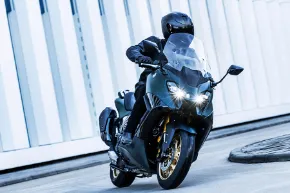Cutting-edge CP4® engine
The R1’s 998cc inline-four-cylinder engine features Yamaha’s exclusive cross-plane crankshaft technology derived from Yamaha's YZR-M1 MotoGP® race bike. By equalizing inertial forces at the crankshaft, the CP4 motor delivers a direct feeling of linear torque, giving the rider the ultimate connection between the throttle grip and the rear wheel.
High-output engine technology
Titanium connecting rods use Yamaha’s precision fracture-split method to ensure maximum reliability with minimal weight. Combined with titanium intake valves and forged pistons, these lightweight parts help achieve the CP4’s high redline and over-rev capability. The cylinder block is also offset from the crankshaft, reducing friction loads on the pistons and bores.
High-performance intake system
The cylinder head, intake system, fuel injectors and airbox work together to enhance part-throttle performance. And by creating a smaller and shorter intake tract, new injectors can spray fuel directly against the intake valves for improved fuel atomization.
Refined rocker-arm valvetrain
Compact rocker-arm valve actuation uses optimized geometry to allow for larger valve lift than conventional cam-driven systems while using lower cam lobes and reduced spring pressure to reduce friction losses.
Titanium exhaust system
The R1 is equipped with a muffler and heat shields manufactured primarily from lightweight titanium. The compact midship muffler also centralizes mass low in the frame and as close to the centre of the machine as possible for optimal handling.
Compact sacked transmission
A 6-speed transmission features close-ratio gearing to best match the high-revving engine. The transmission also "stacks" the input/output shafts to centralize mass and to keep the overall engine size shorter front-to-back, which optimizes engine placement in the frame for outstanding weight balance.
Advanced clutch
Yamaha’s assist and slipper clutch is used to give the rider a more confident downshift when entering corners aggressively, while still smoothly handling the torque of the R1’s high-output motor.
Brake Control (BC) system with ABS
Developed on racetracks around the world, Yamaha’s Brake Control (BC) System works with an Anti-lock Braking System (ABS) to minimize brake slip under aggressive braking or on less-than-ideal surfaces. The adjustable BC System uses the IMU to provide progressive brake force intervention as the lean angle increases which boost rider confidence when braking mid-corner.
Super-bike Braking Components
The YZF-R1 features 4-piston radial-mounted front callipers riding on big 320 mm rotors for excellent stopping power, with a high-friction pad compound, and supported by a 220 mm rear disc with a compact floating calliper. The ABS hydraulic unit is light and compact, and the high-quality braided stainless steel front lines provide firm yet responsive control and feel.
Fully Adjustable KYB® Fork
The R1 features an inverted KYB® front fork with 43 mm inner tubes and an 11,98 cm stroke with full adjustability for an incredible front-end feel on the track. The shim-stack damping pistons improve road feel under aggressive conditions. All adjustments are also made on the top of the fork legs for simplified tuning.
Linkage-type KYB® shock
The fully adjustable KYB® shock utilizes a rear bottom link pivot position that is optimally placed to provide exceptional handling and excellent transmission of engine torque to the track surface. Internal settings are also revised to match the upgraded front fork.
Bridgestone® RS11 tyres
The R1 mounts the latest Bridgestone® RS11 tyres which are designed to offer true racetrack-ready traction with balanced road feel and handling.
Race-ready magnesium wheels
The 10-spoke cast magnesium wheels significantly lower rotational mass compared to conventional aluminium cast alloy rims, reducing unsprung weight for quick direction changes and responsive handling.
Compact Deltabox frame
The slim aluminium Deltabox frame, magnesium subframe and aluminium swingarm contribute to a compact chassis design with outstanding track-focused handling. The motor mounts use the engine as a stressed member of the frame for optimal rigidity balance and fantastic cornering performance on the race track.
Aluminium fuel tank
The aluminium alloy fuel tank weighs in at a full 1,5 kg less than a comparable steel tank, further reducing overall weight, and is sculpted to give the rider a naturally lower body connection to the machine.
Sleek styling
The YZF-R1 features beautifully integrated bodywork and sleek, stylish lines which create an unmistakably aggressive, aerodynamic profile.
All-LED lighting
LED headlights are both lightweight and compact, allowing for a more streamlined design of the front cowling with excellent visibility. The lights deliver a broad spread of illumination. LED front turn signals are integrated into the mirrors for improved aerodynamics while the LED tail light is stylish and highly visible.
Full-colour instruments
The R1 features a brilliant full-colour, thin-film transistor (TFT) meter, with front brake pressure and fore/aft G-force readouts which give the rider feedback from the machine. It features both street mode and a track mode that focuses on performance information, such as YRC settings (including EBM and BC systems), a zoomed-in view of the tachometer in the upper rpm range, a lap timer, gear position indicator and speed.
Ride-by-wire throttle system
The R1 features a ride-by-wire Yamaha Chip Controlled Throttle (YCC-T®) system built around the Accelerator Position Sensor with Grip (APSG), which eliminates the throttle cables. As before, YCC-T precisely senses throttle input by the rider and actuates the throttle valves to actively control intake volume, allowing for cutting-edge computerized engine management but in a lighter package.
Variable intake system
The YZF-R1 features Yamaha’s Chip Controlled Intake (YCC-I®), a variable intake system that broadens the spread of power across the entire rpm range. By actively adjusting the length of the intake based on engine speed, the CP4 engine can provide a broad spread of power across the rpm range.
MotoGP®-level controllability
Yamaha’s Inertial Measurement Unit (IMU) combines a gyro sensor and G-sensor accelerometer that measures all six axes of movement in 3-D space at a rate of 125 calculations per second. This information is fed into the Engine Control Unit (ECU) to create a detailed picture of the motorcycle’s position, which then powers the R1’s rider-assisting technology package, Yamaha Ride Control (YRC).
Engine brake management (EBM)
The YZF-R1 features an Engine Brake Management (EBM) system that allows the rider to adjust engine braking to suit personal preferences and track conditions. The EBM system offers three levels of engine brake force to allow smoother corner entry.
Power delivery mode (PWR)
Power Delivery Mode (PWR) lets the rider adjust engine response to best match their preferences and riding conditions, adjusting throttle feel, responsiveness and overall power. The PWR system offers four settings of progressive power delivery.
Lean angle-sensitive traction control system (TCS)
The R1’s Traction Control System (TCS) calculates the differences in front and rear wheel speeds to monitor and reduce unwanted wheel spin during hard acceleration. Unlike many simplified TC systems, the R1 also uses the IMU to calculate the lean angle and then adjusts the amount of TCS intervention to best suit the rider’s demands. The TCS offers ten separate settings enabling the rider to dial in the exact level of control needed.
MotoGP®-developed slide control system (SCS)
Yamaha’s Slide Control System (SCS) comes directly from the Yamaha YZR-M1 MotoGP® race bike. By using the IMU to detect lateral slides under hard cornering acceleration, the ECU intervenes to regulate power delivery and seamlessly control the motorcycle’s cornering attitude. The SCS features four settings to suit rider preferences and track conditions.
Lift control system (LIF)
The Lift Control System (LIF) utilizes the IMU to detect when the motorcycle’s nose pitches upwards higher or faster than desired, then progressively regulates engine power to maintain chassis attitude with minimal loss of forward drive. LIF offers four settings of adjustment for fine-tuning
Launch control system (LCS)
Built to deliver an optimum racetrack start every time, the R1’s Launch Control System (LCS) limits maximum engine rpm and throttle plate opening with input from the TCS and LIF systems to maximize acceleration from a standing start. The LCS offers three setting levels to adjust engine control and output.
Up & down Quick Shift System (QSS)
The Up & Down Quick Shift System (QSS) uses a sensor on the shift linkage to modulate power during shifting, allowing for split-second clutchless shifts up and down through the gearbox. Full-throttle upshifts maximize forward drive under power, while the ECU precisely matches engine speed while downshifting for nearly instantaneous gear changes with minimal chassis disruption. The QSS can be adjusted between three settings with independent downshift function control.

























